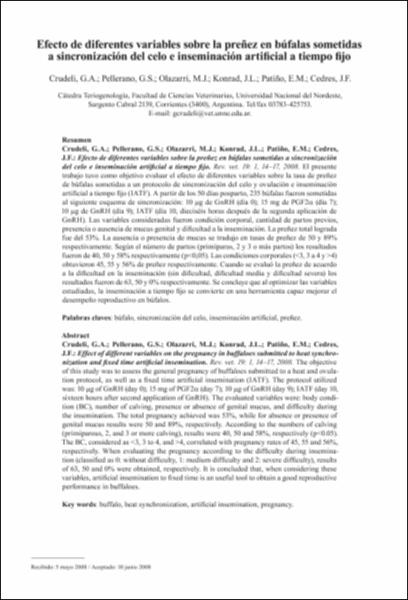Efecto de diferentes variables sobre la preñez en búfalas sometidas a sincronización del celo e inseminación artificial a tiempo fijo
Effect of different variables on the pregnancy in buffaloes submitted to heat synchronization and fixed time artificial insemination
Fecha
2008-08-15Autor
Cedrés, José Feliciano
Pellerano, Gabriela Soledad
Olazarri, M. J.
Konrad, José Luis
Patiño, Exequiel María
Cedrés, José Feliciano
Metadatos
Mostrar el registro completo del ítemResumen
El presente trabajo tuvo como objetivo evaluar el efecto de diferentes variables sobre la tasa de preñez de búfalas sometidas a un protocolo de sincronización del celo y ovulación e inseminación artificial a tiempo fijo (IATF). A partir de los 50 días posparto, 235 búfalas fueron sometidas al siguiente esquema de sincronización: 10 µg de GnRH (día 0); 15 mg de PGF2α (día 7); 10 µg de GnRH (día 9); IATF (día 10, dieciséis horas después de la segunda aplicación de GnRH). Las variables consideradas fueron condición corporal, cantidad de partos previos, presencia o ausencia de mucus genital y dificultad a la inseminación. La preñez total lograda fue del 53%. La ausencia o presencia de mucus se tradujo en tasas de preñez de 50 y 89% respectivamente. Según el número de partos (primíparas, 2 y 3 o más partos) los resultados fueron de 40, 50 y 58% respectivamente (p<0,05). Las condiciones corporales (><3, 3 a 4 y >4) obtuvieron 45, 55 y 56% de preñez respectivamente. Cuando se evaluó la preñez de acuerdo a la dificultad en la inseminación (sin dificultad, dificultad media y dificultad severa) los resultados fueron de 63, 50 y 0% respectivamente. Se concluye que al optimizar las variables estudiadas, la inseminación a tiempo fijo se convierte en una herramienta capaz mejorar el desempeño reproductivo en búfalos. The objective of this study was to assess the general pregnancy of buffaloes submitted to a heat and ovulation protocol, as well as a fixed time artificial insemination (IATF). The protocol utilized was: 10 µg of GnRH (day 0); 15 mg of PGF2α (day 7); 10 µg of GnRH (day 9); IATF (day 10, sixteen hours after second application of GnRH). The evaluated variables were: body condition (BC), number of calving, presence or absence of genital mucus, and difficulty during the insemination. The total pregnancy achieved was 53%, while for absence or presence of genital mucus results were 50 and 89%, respectively. According to the numbers of calving (primiparous, 2, and 3 or more calving), results were 40, 50 and 58%, respectively (p<0.05). The BC, considered as <3, 3 to 4, and >4, correlated with pregnancy rates of 45, 55 and 56%, respectively. When evaluating the pregnancy according to the difficulty during insemination (classified as 0: without difficulty, 1: medium difficulty and 2: severe difficulty), results of 63, 50 and 0% were obtained, respectively. It is concluded that, when considering these variables, artificial insemination to fixed time is an useful tool to obtain a good reproductive performance in buffaloes.
Colecciones
- Artículos de revista [443]





